Menus
- Anything but ordinary
- A pleasure for technology freaks, not so much for aesthetes
- Honda CX 500 developed into a real endurance runner
- Strikingly small turning circle
- Modern mountain bikes have fatter forks
- "Slurry pump! I’m awesome!"
- Technical data Honda CX 500
- Family ties



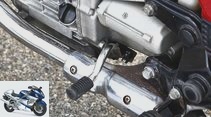

18th photos

www.factstudio.de
1/18
The extraordinary design of the CX 500 did not appeal immediately.
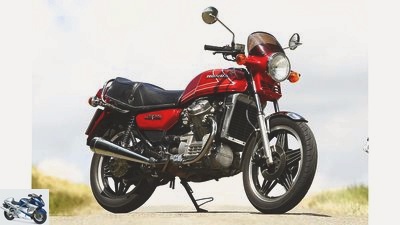
www.factstudio.de
2/18
Two-cylinder 80 degree V engine, 496 cm³, 37 kW (50 PS) at 9000 rpm.
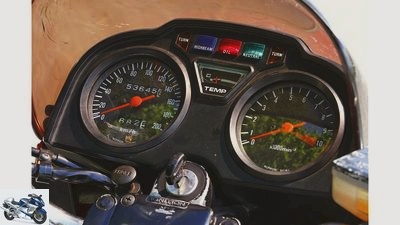
3/18
Tidy instruments, still without a combined ignition / steering lock.
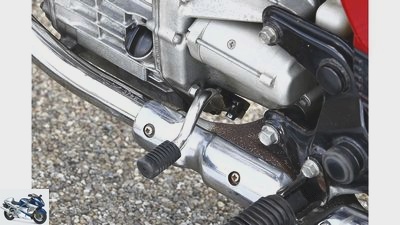
www.factstudio.de
4/18
The directly mounted shift lever saves a diversion with playful joints.
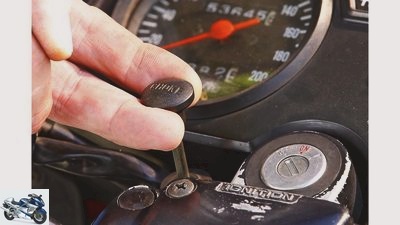
www.factstudio.de
5/18
All through the Eighties, this choke button has accompanied generations of Honda drivers.
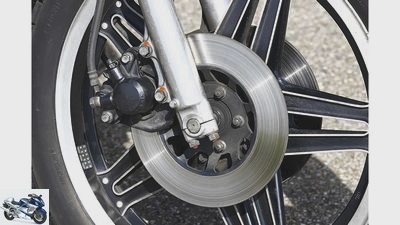
www.factstudio.de
6/18
Single-piston floating calipers with 240 mm discs can be found on the rear wheel today.
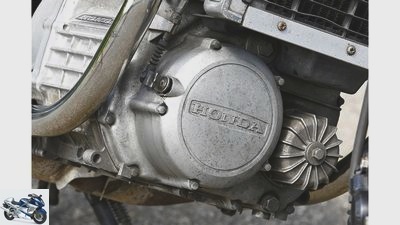
www.factstudio.de
7/18
The oil bath clutch in front of the engine rotates in the opposite direction to the crankshaft.
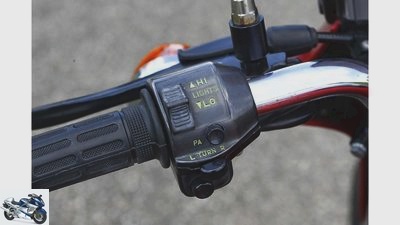
www.factstudio.de
8/18
At a time when the pushbutton to turn off the turn signals was not yet invented.
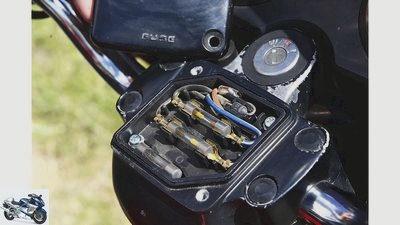
www.factstudio.de
9/18
Keep it simple: Two glass fuses had to be enough given the manageable electrical system.
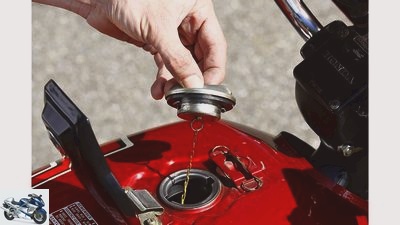
www.factstudio.de
10/18
Cumbersome tank cap, first open the flap, then unscrew the tank cap.
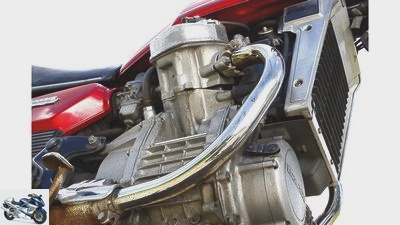
www.factstudio.de
11/18
The engine housing and cylinder, into which the gray cast iron liners have been drawn, are cast in one piece.
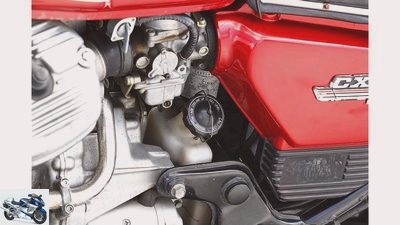
www.factstudio.de
12/18
Honda CX 500.
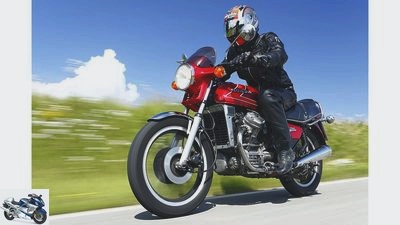
www.factstudio.de
13/18
Honda CX 500.
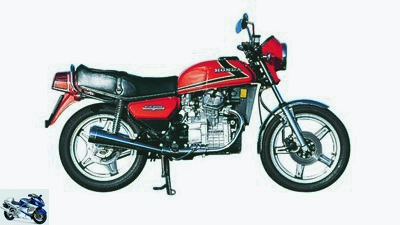
14/18
The first: In 1978 the CX 500 came into the range with silver Comstar wheels, but still without a window on the cockpit fairing; it was the only CX that did not have a 650 variant.
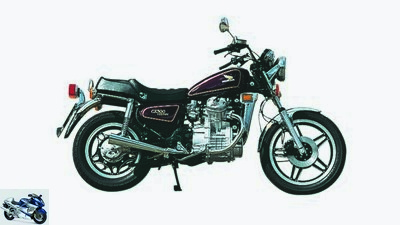
15/18
The CX 500 C, released in 1980, with a step bench and a small drop tank, swam quite successfully on the soft chopper wave, from 1983 as the CX 650 C..
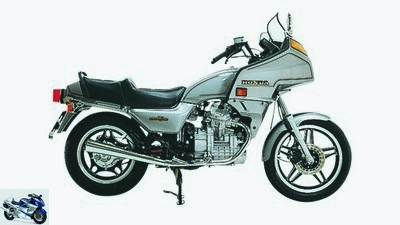
16/18
From 1982 onwards, the GL 500 Silver Wing with its lavish fairing was an alternative for those for whom the Gold Wing was too powerful. Like the CX 500 C, it was replaced by the 650 in 1983.
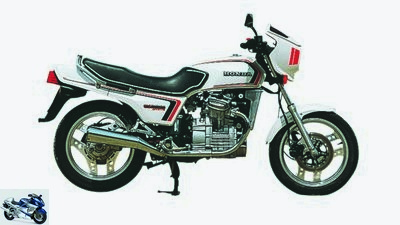
17/18
1982 was the year of innovation. In addition to the CX 500 C, the Euro design of the CX 500 E brought a breath of fresh air. And the Pro-Link central spring strut. The 650 series followed a year later.
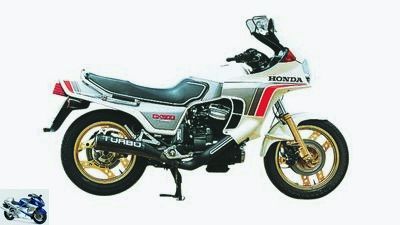
18/18
At the same time as the “E”, the 82 hp 500cc turbo was added to the range, which around 400 buyers chose. Only 77 buyers wanted the 100 hp 650cc turbo, released in 1983.
Impression Honda CX 500
Anything but ordinary
The Honda CX 500 was to conquer the middle class in 1978 with exceptional technical solutions and exceptional design. But she missed the zeitgeist and had to work hard for her recognition.
"As ugly as the machine looks, it drives so well", was the rough but heartfelt conclusion of the first Honda test C.X 500 in MOTORRAD 3/1978. The chubby design did not meet with much approval at the time. The line rising strangely towards the front, the knobbly lamp cover, plus Comstar wheels. Above all the water-cooled V2 with its strangely twisted, smooth-surfaced cylinders, everything shook our viewing habits violently, even if the Gold Wing was already a water-cooled model in the program. And anyway: Honda had the middle class well filled with beautiful, powerful four-cylinder engines.
Buy complete article
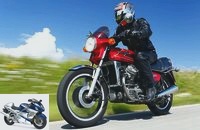
Impression Honda CX 500
Anything but ordinary
V-motor installed lengthways, cardan shaft, water cooling
From today’s perspective, the Honda CX 500 still looks at least quirky. But no less independent and interesting. It is worth taking a look at the technology that Honda had packed into the motorcycle. There is hardly a convention that the technicians have not broken with this design. Of course, there were V-engines and cardan shafts installed lengthways elsewhere. But combined with water cooling in a mid-range model, that was new. As well as many other technical tricks. The engineers had dug deep into their bag of tricks to put a motorcycle on its wheels that “can be described as extraordinary”. So the advertising text.
The technicians have rotated the cylinders by 22 degrees to the longitudinal axis, which not only gives the driver more space, but also enables straighter, performance-enhancing intake paths. In contrast to BMW and Guzzi, the clutch of the Honda CX 500 is not located as a huge flywheel at the interface between the engine and the blocked transmission, but as an oil bath clutch in front of the engine. And rotates against the crankshaft, which largely eliminates the breakdown torque of the engine when accelerating. A trick that BMW rediscovered today with the water boxer.
A pleasure for technology freaks, not so much for aesthetes
But that wasn’t all. The engine housing and cylinder of the Honda CX 500 were – a novelty – made in one piece. Which saved both processing steps and a sealing point. A camshaft in the V of the cylinder drove the four valves per cylinder via short, lightweight bumpers. This saved the overhead camshaft, and thus costs and overall height, and still allowed decent speeds. The valves were arranged so that the spark plugs could be housed centrally in the combustion chambers. The engine was designed with a short stroke, which allowed speeds of up to 10,000 rpm, with a very high compression ratio of 10: 1 and still managed with regular gasoline. The resulting 100 hp liter output was remarkable for a twin. In addition, it spread its cylinders at an exotic angle of 80 degrees in order to save construction width, and was clamped into the unusually shaped frame as a load-bearing element. And the Comstar rims, which took no less getting used to, had tubeless tires. All in all a pleasure for technology freaks, but not so much for aesthetes – or those who thought they were.
So pulled the choke button and pressed the starter a little longer. Then our unit, which has already run almost 54,000 kilometers, willingly starts and bubbles with that typical, guttural V2 sound content while idling. Even today it sounds mechanically very quiet.
Honda CX 500 developed into a real endurance runner
“That’s how I always wanted my Guzzi to work,” says boss Michael Pfeiffer during a sound check in the editorial underground car park. Well boss, user-friendly and reliable, that was just typical Honda at the beginning of the 80s. After initial minor problems with breaking timing chain tensioners and leaky water pumps, the Honda CX 500 developed into a real endurance runner. And even today you can find copies in the usual Internet portals, which are offered for sale with around 90,000 kilometers. The first gear engages dryly, and the journey can begin.
The seating position does not seem antiquated, upright behind the surprisingly wide handlebars, more in than on the motorcycle. The engine gently picks up the gas from idling speed, and before you leave your home 30 km / h zone, you can already use the fourth of five gears. No jerking, no swallowing. The Honda CX 500 stomps and thuds in a well-muted state, the end of the town comes within sight, fifth gear and out onto the open country road.
Despite the unusual cylinder angle, the V2 runs amazingly smoothly in the first half of the rev range. Takes on gas gently and with extremely low gimbal reactions. No comparison to the elevator-like ups and downs of the BMWs of that time.
Strikingly small turning circle
Honda used the remarkable speed of the four-valve engine to produce a very short overall gear ratio. So the Honda is already turning a good 5000 rpm at country road speed. Contrary to what the beefy appearance suggests, the Honda CX 500 is rather reserved at the bottom. If you want to move quickly, the second half of the speed is required. There the CX gets really lively and develops its temperament with surprising revving. Gentle drumming in the notches from 7000 rpm shows that the mass balance is not quite on the high level of a 90-degree V2, but these expressions of life are harmless in nature.
The Honda CX 500 makes everyday life easier with small amenities such as easy jacking up or the strikingly small turning circle. It fits in perfectly with the thoroughly sociable character of the CX, which, in addition to its robustness, ultimately earned it such a large fan base. And the MOTORRAD endurance test may have contributed to this. Practically no oil consumption over the 25,000 kilometers that were still common at the time, and after the typical initial problems with the timing chain tensioner, impermissible wear was only noticeable on the valve guides. That cemented the reputation of the CX as a frugal, robust touring machine. Just like the successful chassis.
Modern mountain bikes have fatter forks
Foolproof steering behavior, minimal pitching tendency, that’s how the Honda CX 500 circles around corners in a relaxed manner. With the latest rubber soles, in this case Michelin Pilot Activ, you can turn in and change direction without much fuss. And even in quick arcs, the 500 pulls its course calmly and with concentration.
By no means a matter of course in times when wobbling undercarriages were still the order of the day. And quite astonishing in view of the chassis details such as the bulky front axle or the slim 33 mm stanchions on the telescopic fork. In the meantime, modern mountain bikes have fatter forks than the Honda CX 500. Nevertheless, there is a sense of well-being on board, because it is not just the chassis that keeps pace with it. The engine is thermally very healthy. Even at a brisk pace, the needle on the water temperature display never moves beyond the middle position. Only the brakes require a somewhat foresighted driving style on a brisk country road ride. Because although it was highly praised at the time, the double disc brake with its single-piston floating calipers and 240 mm discs – these dimensions usually adorn rear wheels today – has probably become a bit milder over the years and by today’s standards only develops a manageable bite. However, it is effectively supported by the drum brake in the rear wheel.
"Slurry pump! I’m awesome!"
Incidentally, our specimen clearly distanced itself from the test consumption of six and a half to seven liters at the time. The Honda CX 500, which reader Daniel Kiessner kindly made available to us, consumed just under five liters.
The iconic Honda CX 500 now has a loyal fan base – not least as a basis for more or less ambitious vintage conversions. And so today it is given the respect it deserves that was initially denied when it was launched. What is best illustrated by an incident on the drive home after the end of this test, through the traffic jam on the clogged A8: The passenger of a van discovers the red CX in the rearview mirror, leans out of the window with a broad grin and shouts with a raised thumb: "Slurry pump! I’m awesome!"
Technical data Honda CX 500
Two-cylinder 80 degree V engine, 496 cm³, 37 kW (50 PS) at 9000 / min, 43 Nm at 7000 / min, single-tube steel frame, telescopic fork,
Double disc brake at the front, drum brake at the rear, Ø 240/160 mm, weight with a full tank 221 kg, tank capacity 17 liters, price (1978) 5620 marks
Family ties
archive
Honda CX 500 E from 1982.
- The first: In 1978 the Honda CX 500 came into the range with silver Comstar wheels, but still without a window on the cockpit fairing; it was the only CX that did not have a 650 variant
- The Honda CX 500 C, released in 1980, with a step bench and a small drop tank, swam quite successfully on the soft chopper wave, from 1983 as the CX 650 C.
- From 1982 onwards, the GL 500 Silver Wing with its lavish fairing was an alternative for those for whom the Gold Wing was too powerful. Like the Honda CX 500 C, it was replaced by the 650 in 1983
- 1982 was the year of innovation. In addition to the Honda CX 500 C, the Euro design of the CX 500 E brought a breath of fresh air. And the Pro-Link central spring strut. The 650 series followed a year later
- At the same time as the “E”, the 82 hp 500cc turbo was added to the range, which around 400 buyers chose. Only 77 buyers wanted the 100 hp 650cc turbo, released in 1983
Related articles
-
New items 2019 Top topic Honda Honda CB 650 R (2019) in the driving report Mid-range four-cylinder in Neo Sports Cafe design At the Paris Motor Show,…
-
On the move: Benelli 750 Sei, Honda CBX 1000, Kawasaki Z 1300
Bilski 17th photos Bilski 1/17 Who is the widest in the whole country? The angle of spread of the driver’s legs provide information. Bilski 2/17 With…
-
Driving report Honda CRF 1000 L Africa Twin (part 1)
Honda 13 photos ULA SERRA PRATS 1/13 Honda Africa Twin. 2/13 270 degree crank pin offset, long, continuous shaft with two balance weights in front of the…
-
fact 12 pictures fact 1/12 Top brakes: radially screwed six-piston stoppers, ABS and integral actuation. fact 2/12 Builds compact and very narrow: the …
-
On the move with the Honda MVX 250 F.
Wolf 29 pictures Wolf 1/29 The MVX was not a big seller, but the speedster with the V3 engine is still a lot of fun. Wolf 2/29 Wolf 3/29 Wolf …
-
Comparison test: Honda CX 500-650 Turbo, Kawasaki Z 750 Turbo, Suzuki XN 85, Yamaha XJ 650 Turbo
Jahn 21 pictures Jahn 1/21 The preload of the central spring strut of the Suzuki can be easily adjusted. Jahn 2/21 Tight corners and fast …
-
On the move: the Honda VF 500 F II and Yamaha RD 500 LC
fact On the move: Honda VF 500 F II and Yamaha RD 500 LC Extreme athlete Content of At the beginning of 1984, the Honda VF 500 F II and Yamaha RD 500 LC…
-
On the move with the Honda GL 1000 Gold Wing
Jahn 11 photos Jahn 1/11 In view of the enlightening driving impressions with the Honda Gold Wing from 1977, some old prejudices have to be straightened…
-
On the move with Honda CB 1100 F and Kawasaki GPZ 1100 B2
www.factstudio.de 29 photos factstudio.de 1/29 Picture gallery: Honda CB 1100 F and Kawasaki GPZ 1100 B2 on the move. factstudio.de 2/29 Honda CB 1100 F…
-
On the move with the Honda NR 750
Arturo Rivas 15th photos Alan Cathcart 1/15 The 32-valve is a technical masterpiece that only Honda has mastered Arturo Rivas 2/15 The NR doesn’t sound…